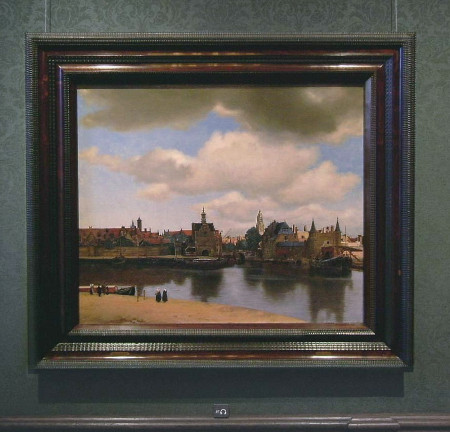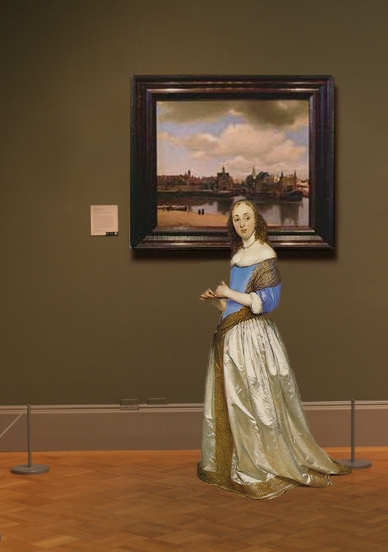View of Delft
(Gezicht op Delft)c. 1660–1663
Oil on canvas, 98.5 x 117.5 cm. (38 3/4 x 46 1/4 in.)
Mauritshuis, The Hague
inv. 92

The textual material contained in the Essential Vermeer Interactive Catalogue would fill a hefty-sized book, and is enhanced by more than 1,000 corollary images. In order to use the catalogue most advantageously:
1. Scroll your mouse over the painting to a point of particular interest. Relative information and images will slide into the box located to the right of the painting. To fix and scroll the slide-in information, single click on area of interest. To release the slide-in information, single-click the "dismiss" buttton and continue exploring.
2. To access Special Topics and Fact Sheet information and accessory images, single-click any list item. To release slide-in information, click on any list item and continue exploring.
The tiny figures
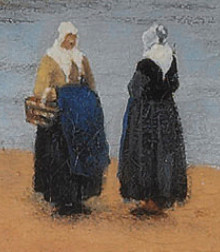
Vermeer included about 15 figures in the View of Delft. The costumes of the six foreground figures indicate their social standing, from the fashionable attire of the three burghers standing by the boat, to the simpler regional or peasant clothing—black skirts and jackets with white collars and shoulder cloths—worn by the other women. The artist had initially included a broad-hatted man just to the right of the two women but later painted over him.
Two elderly individuals to the right converse as they wait for the next horse-drawn tugboat that will carry them to The Hague or Leiden. Both wear similar headgear and blue aprons, which appear frequently in Dutch paintings depicting daily life. The woman on the left carries a basket. Originally, there was a man standing to the right of the two figures, but Vermeer painted over him.
A windless morning
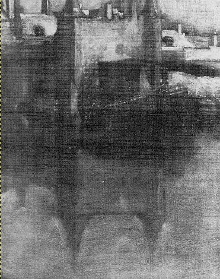
The delicate ripples on the waterway's surface, which one art historian compared to a satin dress by Gerrit ter Borch, indicate an almost windless morning. The slight movement of the water causes the reflections of the skyline to be partially blurred, an effect that enhances the mystery of the image. However, radiograph images show that this effect was not originally intended by Vermeer. The reflections were far more precise than they are in the final version. The Rotterdam Gate was not entirely cast in shadow as it appears today, but rather received more light, which would have created greater contrast.
Dutch clouds
The section of the painting that portrays the Delft's buildings is surprisingly not much more expansive in surface area than the unobtrusive dark cloud that initially eludes our attention.
A low-flying, billowy cumulus cloud casts a momentary shadow on the foreground harbor, while the rest of the city is bathed in early morning light. The spectator feels the scene is alive—not frozen—but suspended in time. Only a minute later, the clouds would have continued their ceaseless march and completely altered the patterns of light and dark in the scene. Vermeer was hardly the first painter to exploit the movement of clouds to achieve the psychological effect of temporality.
With the exception of some landscapes by, among others, Jacob van Ruisdael and Philips Koninck, these types of clouds are not encountered in 17th-century Dutch paintings. Imaginative Dutch landscape painters routinely used the shadows of clouds to create spectacular lighting effects, which could enliven their beloved but largely uneventful landscapes. The moisture-laden clouds across the top of the painting close off the composition, impeding the eye from straying out of the scene. The art historian Walter Liedtke noted that the cloud formations in the View of Delft recall a scheme that the great Dutch landscape painter Jacob van Ruisdael employed in the same period.
According to Dutch meteorologist Peter Kuipers Munneke, it is entirely possible to find modest cumulus clouds like these in the Netherlands. They often develop in the summer with a slight westerly wind and then, in the west of the country, form so-called "cloud streets," reminiscent of the lined-up clouds in the picture.
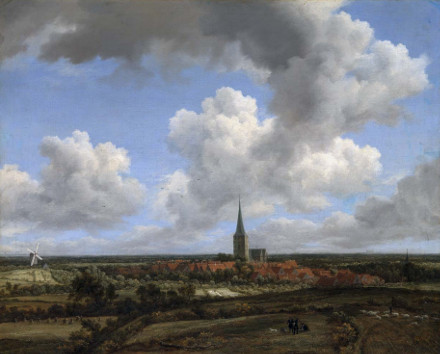
Wheat Fields
Jacob van Ruisdael
c. 1670–1675
Oil on canvas, 59.1 x 73.2 cm.
Alte Pinakothek, Munich
The sky was executed with large, flat brushes (a few hog hairs remain embedded in the paint) over a white base, which heightens the luminosity of the subtle, pastel grays and light blues. Approaching the horizon, the pale blue was lightened with lead white, plus a small quantity of lead-tin yellow to intensify the pale tint.
Different kinds of boats
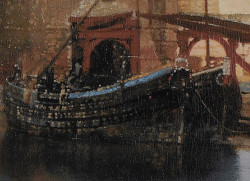
In the present pictures, various types of ships are portrayed. Among them is the wijdschip, a substantial type of kromsteven (flat coastal cargo ships up to 1200 tons), often used for long-distance ferrying. These were either longer than 18.4 meters or wider than 4.68 meters to distinguish them from narrower crafts known as windtschip. Further characterizing these ships is a large, paddle-shaped object known in Dutch as a zwaarden, or leeboard, attached midway along the boat's hull. The necessity for this leeboard arises from the unique construction of the boats, designed to navigate the narrow Dutch canals. While their shallow, wide and flat bottoms—typically less than one meter deep—allow them to do so, this shape poses challenges in terms of wind resistance. To counteract this, the leeboard is lowered into the water on the side opposite to where the wind is coming from, offering resistance and preventing the barge from being blown sideways.
Another featured ship is an inland sailing vessel with a curved stern, possibly a type known as a smalschip. Complementing these are five small tow-boats, known in Dutch as trekschuit. These boats were used for centuries in the Netherlands for the regular transportation of people and small commodities between cities along canals referred to as trekvaarten. The speed of the tow-boat was about seven kilometers per hour—faster than walking and considerably more comfortable than travel by coach. With a flat bottom and dimensions of approximately 11 meters in length and two meters in width, the tow-boat could accommodate between 24 to 30 passengers, who sat under a tent-like structure formed by a tarpaulin stretched over hoops. The rear of the ship featured a wooden deckhouse reserved for first-class travelers.
The tow-canals, or trekvaarten, were engineered from existing ditches or canals widened to about 20 meters and reaching depths of a few meters. Along these canals ran towpaths, where draft horses would walk, pulling the barge through the water. The straight lines in which these canals were dug ensured the shortest route. Often, the person riding the horse was a "'hunter" or snikjon, usually the skipper's son, who weighed less than an adult. The operation ran on a strict timetable; latecomers were not accommodated, and if the barge itself was late to its destination, the skipper was obliged to refund the passengers' travel money.
Kees Kaldenbach, a Dutch art historian and expert on both Delft and Vermeer, has conducted extensive research into the artist's connections with his hometown of Delft. Among other insights, Kaldenbach was able to determine the likely season in which the painting was made, based on the conditions of the various ships that populate the harbor. "Each year the active season of the herring buses was limited by law from June 1st to the end of December. Herring buses were costly investments. These ships were used optimally during that legal fishery season. These two ships are however far away from their regular harbor of Delfshaven and are clearly under repair, missing a few masts and being otherwise empty, floating extremely high on the water. This in turn indicates an early season for the total scene. Given the orientation of the scene, the full green foliage and the active maintenance works on these two ships which are moored at the Delft shipyard—getting ready before June 1st—it follows that the intended scene and/or the actual conception of this painting must be dated at an early morning in the first half of May."
The Rotterdam Gate
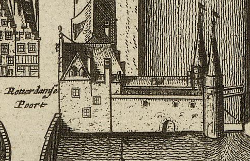
The Rotterdam Gate at Delft (detail)
Jan van Kessel
c. 1649–1669
Black chalk, pen and brown ink, 17.9 x 24.4 cm.
Musées Royaux des Beaux-Arts de Belgique, Brussels, De Grez Collection
This large structure, dating back to medieval times, was known as the Rotterdam Gate, one of the four city gates. Other than its defensive function, it was used as a meeting place by the members of the seamen's guild. To enter the city, one first had to cross a drawbridge before arriving at the forward part of the building with two pointed, octagonal turrets. Watchmen controlled the entrance from a room directly above the drawbridge. Behind the entrance lay a narrow corridor that lead to and through the main building, outside of which was the Voldersgracht canal flanked by the de Geer. The Rotterdam Gate had kept much of its late-medieval character in the 17th century
In a drawing by Jan van Kessel, the purpose of the structure is clear, featuring a crenelated top, arrow slits and openings for aiming and firing weapons. Between the defensive fortifications and the city gate, a lengthy covered bridge spans most of the moat. The Rotterdam Gate was eventually dismantled in 1836. The sole surviving Delft gate is the charming Oostpoort, whose paired towers are often confused by tourists for the Rotterdam Gate.
When comparing the location to a segment of the extensive Kaart Figuratief of Delft from the mid-1670s, it becomes apparent that the building is slightly more irregular than Vermeer depicts. Notably, the twin towers appear to extend further out into the water. Evidently, Vermeer adjusted the angle of the gate, distorting the perspective to achieve a more condensed composition.
In a drawing by the topographical artist Abraham Rademaker, captured from a slightly closer and lower viewpoint than Vermeer's, the overall look of the area is similar, even though it only portrays a section of the Rotterdam Gate. Rademaker, like many other artists who depicted the area, accentuated the horizontal bands on the gate's side, created by alternating layers of brick and light-colored natural stone. Vermeer toned down these features to give the structure a sturdier appearance.
Interestingly, an analysis of the View of Delft using x-radiography and infrared reflectography has revealed that the artist initially depicted the twin towers illuminated by bright sunlight. Additionally, the reflections of the Rotterdam Gate were more precisely defined. In the final version, however, Vermeer intentionally blurred them and extended them downward to intersect with the picture's bottom edge, providing compositional cohesion.
The Schiedam Gate
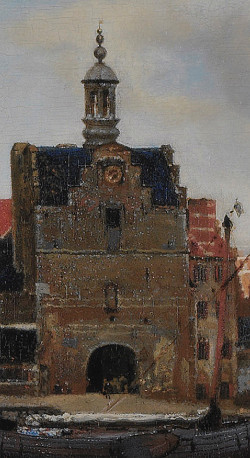
The Schiedam Gate is positioned to the left of the stone bridge and the Rotterdam Gate. It was built together with the Rotterdam Gate beginning 1396, when permission was given to Delft to rebuild its gates and city walls. It would take until after 1514 before the both gates were completed. The Schiedam gate once had twin towers like those in the Rotterdam Gate, but were altered in 1590-1591 and 1614. From Vermeer's point of view, the building seems rectangular but in fact it is diamond-shaped. The main building is constructed with red bricks, alternating with thin layers of limestone.
Delft's city gates were constructed to oversee both water and land traffic and to safeguard the city against potential enemy attacks. A portcullis could be lowered to secure the town's entrance. Until the mid-18th century, these gates also functioned as collection points for a city excise tax, applied to all goods transported via roads and waterways. Not a single stone remains from the two ancient gates, following the demolition of the Schiedam Gate in 1834 and the Rotterdam Gate in 1836.
In The View of Delft, Maria Thins' residence on Oude Langendijk—where Vermeer and his family resided—would be situated just to the right of the New Church tower, which commands the view. A small clock indicates the time as approximately seven o'clock. Previously, "a projecting structure identical to the one on the right side of the Rotterdam Gate stood at the entrance to the Schiedam Gate. In 1614, everything preceding the Schiedam Gate proper was removed to make way for the Kolk, a triangular harbor where Vermeer's vessels were docked.
Artistic license

Although there exist many Dutch cityscapes, none are able to transport the viewer back in time and convey the material sense of water, air, brick and mortar as much as Vermeer's View of Delft. When we stand in front of the picture, it is almost as if we had been projected in a time capsule to the southern ramparts of Delft's city gates in the early 1660s.
Even if the architectonic rendering is fundamentally accurate, Vermeer did not follow the topographical convention of emphasizing the major landmarks. He also took artistic license altering dimensions and contours of some of the main buildings. In this detail, one of the largest and most venerable monuments in Delft, the Old Church, is almost concealed. We can barely catch a glimpse of the grayish top of the complicated Gothic spire, which timidly peers out just above the skyline. Curiously, even though the area portrayed in the View of Delft has been heavily reconstructed over the centuries, the same slice of the Old Church's tower is still visible over the modern skyline.
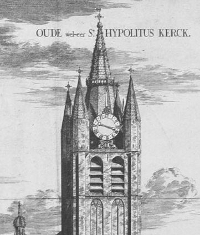
Exterior of the Old Church in Delft (detail)
Coenraert Decker
Engraving, 33 26.7 cm.
From Dirck van Bleyswijck's Beschryving der
Stadt Delft
Delft, 1667
Private collection
Tae leaning tower of the Old Church, probably built on an early filled-up canal, has been the cause of considerable alarm to local inhabitants. In 1843, the City Council of Delft, fearing the collapse of the tower, decided that it had to be pulled down to the level of the church roof. Local contractors were able to prevent this decision from actually being carried out. Nowadays, the leaning tower of the Old Church is a prominent emblem of Delft, fondly called by the citizens the "Scheve Jan" ("Leaning Jan").
On 15th December 1675, Johannes Vermeer was buried in the Old Church, in a family crypt in the northern transept, bought by his mother-in-law Maria Thins in 1661. But when he died, there was no money for a tombstone. Today his burial place has two grave markers: one, rather austere, placed in 1975 to commemorate the 300th anniversary of the artist's death, and a larger, discreetly decorated one near the western side entrance placed on 26th January 2007. Even though the exact location of Vermeer's tomb, the great Delft artist is in the company of some of the city's most excellent citizens.
The New Church
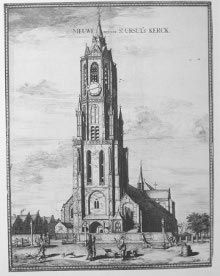
Exterior of the New Church in
Delft (detail of Old Church)
Coenraert Decker
Engraving, 33 26.7 cm.
From Dirck van Bleyswijck's Beschryving der
Stadt Delf, Delft, 1667
Private collection
While the tower of the New Church is forcefully depicted that it seems real, it is not totally accurate in its dimensions. Vermeer's tower generally differs from those of other topographical renderings of the same spot. In a rather picturesque view by Jan de Beyer dated 1750 the tower is much higher. The proportions of the existing building suggest that Vermeer' made his tower somewhat wider and somewhat lower, perhaps, in order to minimize its scale and emphasize its distance from the foreground plane. It also blends more successfully with the horizontality of the composition than had it been larger. In order to accentuate the tower's luminosity and make it stand out, the sunlit portions were painted with heavy impasto lead-tin yellow, the brightest yellow pigment available to artists of the time.
Much has been made about the scene's historical importance. The New Church had a deep meaning not only for the citizens of Delft but for all Dutchmen. It quickly gained fame in the 17th century with the construction of the tomb of William of Orange, the 16th-century prince who had led the Northern Netherlands in their revolt against Spanish governance. The Father of the Fatherland, as he became known, had chosen Delft as his residence, and it was there, in 1584, that a political adversary assassinated him. The New Church remains the place of the final rest of nearly all members of the house of Orange-Nassau, including all Dutch monarchs.
In its times, the New Church was already an object of honor and admiration and destination for thousands of tourists each year, whether Dutch citizens or foreigners. It may very well have been one of the most frequently depicted buildings in the Netherlands.
The gabled rooftops of Kethel Street
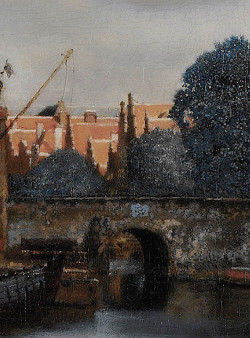
The row of illuminated gabled rooftops is situated on Kethel Street, one of the three streets which branched out, and still branches out today, from behind the Schiedam Gate. Kethel Street runs perpendicular to the foreground quay.
According to research conducted by the art historian Kees Kaldenbach, careful measurements 'carried out in the early 1980s show that the interval of these houses mirrors that of the plots of the present-day homes (which are each about 4 m. wide). After these measurements were carried out, all of these buildings were sadly demolished. One of the houses had a stone ornament that bore the inscription 1670. In depicting this row of houses, Vermeer clearly did copy reality very faithfully.

A stepped gable, crow-stepped gable, or corbie step is a stairstep type of design at the top of the triangular gable-end of a building. The top of the parapet wall projects above the roofline and the top of the brick or stone wall is stacked in a step pattern above the roof as a decoration and as a convenient way to finish the brick courses.
Most of Delft's older buildings had decorative step gable roofs in a range of style, which also provide an insight into the history of the building. A stepped gable, crow-stepped gable, or corbie step is a stairstep type of design at the top of the triangular gable-end of a building. As the name suggests, a step gable resembles a series of steps, gradually narrowing towards the top. It looks like a staircase leading up the façade of a building. Besides the decorative aspect, step gables offer practical advantages. The "steps" provides a convenient way to finish the brick courses and easy access to the roof for "chimney sweeps" and roofers in earlier times when cranes were non-existent and tall ladders were not common.
Over time, gables became decorated with a variety of crests, scrolls, and even coats of arms. The protruding hooks (hoist beams) are used in moving objects (like furniture and appliances) through windows since stairways are quite narrow.
special topics
- Delft's artistic decline
- An empty bell tower
- Thoré-Bürger and the View of Delft
- The Kolk
- How Vermeer's view looks today
- Traveling by boat in 17th-c. Netherlands
- Marcel Proust and the View of Delft
- Why did Vermeer paint the View of Delft?
- Dutch pride
- Did Vermeer use a camera obscura in the View of Delft?
- Delft draws inward
- Listen to New Church carillon music
fact sheet
- Signature
- Date
- Provenance
- Exhibitions
- Technical description
- Before and after images of he painting after its 2012 restoration
- The painting with its frame
- How big is this picture?
- Download High-Resolution Image from Mauritshuis
- Google Art Project ultra zoom image
- Historic timeline of the year(s) Vermeer created this painting
- Related artworks
Critical assessment
Vermeer's View Delft is probably the most memorable cityscape in western art. Though not an interior scene, like most works by Vermeer, the painting draws us into his mental and social world: into his artistic vision and his city. What we see seems almost too obvious, too plainly descriptive, too perfectly observed to require comment or analysis: the city of Delft appears before us under the partial clouds characteristic of the North Sea climate, a palpable grouping of brick, mortar and clay structures seen across the broad Schie canal. It is all there, still nameable today: the Schiedam gate at left, the Rotterdam gate with its twinned turrets at right, the tower of the New Church picked out in the brightest sunlight, the diminutive tower of the Old Church just breaking the long roofline at left. The scene's varied light effects look so natural -deep shadow and bright patches, pinpoint highlights and watery reflections -that the eye ignores what the mind knows: that this light is high artifice, that it is a work of painting.
Mariët Westermann, "Vermeer and the Interior Imagination," Vermeer and the Dutch Interior
The signature

Signed lower left on the boat: IVM (in monogram)
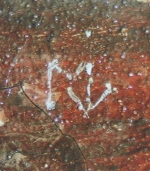
(Click here to access a complete study of Vermeer's signatures.)
Dates
1661
Albert Blankert, Vermeer: 1632–1675, 1975
c. 1660–1661
Arthur K. Wheelock Jr., The Public and the Private in the Age of Vermeer, London, 2000
c. 1661–1663
Walter Liedtke, Vermeer: The Complete Paintings, New York, 2008
c. 1660–1661
Wayne Franits, Vermeer, 2015
(Click here to access a complete study of the dates of Vermeer's paintings).
Technical report
The support is a fine, plain-weave linen with a thread count of 14 x 13 per cm² and selvedges on both left and right sides. Strainer bar marks have resulted from a vertical cross bar and corner braces. The canvas has been lined. The buff-brown ground, bound with oil and some protein, contains chalk, lead white, ocher, a little umber and a little black.
The composition was built up in light and dark passages. The sky, foreground and light parts of the water are laid in with lead white while the town and its reflection were left in reserve. Some parts of the townscape are underpainted with black. A rough surface texture was created in many places, particularly in the stone facades, and in the roofs, by underpainting with lead white containing exceptionally coarse pigment particles mixed with sand. The fine yellow ocher paint of the stepped gable to the left contains transparent rounded particles of sand.
* Johannes Vermeer (exh. cat., National Gallery of Art and Royal Cabinet of Paintings Mauritshuis - Washington and The Hague, 1995, edited by Arthur K. Wheelock Jr.)
Provenance
- (?) Pieter Claesz. van Ruijven, Delft (d. 1674);
- (?) his widow, Maria de Knuijt, Delft (d. 1681); (?) their daughter, Magdalena van Ruijven, Delft (d. 1682);
- (?) her widower, Jacob Abrahamsz Dissius (d. 1695); Dissius sale, Amsterdam, 16 May, 1696, no. 31;
- Willem Philip Kops, Haarlem and Bloemendaal (before 1805);
- Cornelia Kops-de Wolf, Bloemendaal (1805–1820);
- Anna Johanna Teding van Berkhout-Kops, Haarlem (1820–1822);
- S. J. Stinstra et al. sale, Amsterdam (J. de Vries), 22 May, 1822; no. 112, to J. de Vries;
- purchased by The Netherlands for the Koninklijk Kabinet van Schilderijen Mauritshuis, The Hague (inv.92).
Exhibitions
- Paris April–May, 1921
Exposition hollandaise: Tableaux, aquarelles et dessins anciens et modernes
Jeu de Paume
10, no. 104 - London January 4–March 9, 1929
Exhibition of Dutch Art, 1450–1900
Royal Academy of Arts
144, no. 304 - London January 4–March 9, 1929
Dutch Art. An Illustrated Souvenir of the Exhibition of Dutch Art at Burlington House, London.
Burlington House.
85, no. 103 and ill. - Amsterdam 1945
Weerzien der meesters
Rijksmuseum
no. 132 - Delft November–April, 1950
Het Koninklijke kabinet "Het Mauritshuis" in het museum 'Het Prinsenhof' te Delft
Stedelijk Museum Het Prinsenhof
11, no. 25 - The Hague June 25–September 5, 1966
In het licht van Vermeer
Mauritshuis
no. 3 and ill. - Paris September 24–November 28, 1966
Dans la lumière de Vermeer
Musée de l'Orangerie
no.3 and ill. - Paris February 19–June 30, 1986
De Rembrandt à Vermeer: Les peintres hollandais au Mauritshuis à la Haye
Grand Palais
350–557, no. 53, ill. (with extensive literature) - Washington D.C. November 12, 1995–February 11, 1996
Johannes Vermeer
National Gallery of Art
120–127, no. 7 and ill. - The Hague June 25–September 5, 1966
Johannes Vermeer
Mauritshuis
no. III and ill.120–127, no. 7 and ill. - The Hague February 1–May 3, 2009
Pride and Place: Dutch Cityscapes of the Golden Age
Mauritshuis
185–188, no. 49 and ill. - The Hague April 28, 2012–June 30, 2014
Meesters uit het Mauritshuis Zes eeuwen kunst onder een dak (Highlights Mauritshuis in Gemeentemuseum The Hague)
Gemeentemuseum The Hague - The Hague October 7, 2021–January 9, 2022
Facelifts & Makeovers
Mauritshuis, The Hague - Amsterdam February 10– June 4, 2023
VERMEER
Rijksmuseum
no. 10 and ill.
(Click here to access a complete, sortable list of the exhibitions of Vermeer's paintings).
| Vermeer's life |
Vermeer is appointed one of the headman of the Guild of Saint Luke to a term of two years. This fact has been interpreted as a testimony of the high esteem in which the artist was at the time held. However, by the time Vermeer was elected headmaster, many of the painters resident in Delft had left for the more prosperous Amsterdam and so his election may have had less significance than usually thought. Vermeer and his wife bury a child in the Old Church in Delft. The same document states, Vermeer and his wife were then living in the house of Maria Thins on the Oude Langendijk in Delft. At the time, the household included Vermeer, his wife, his mother-in-law and three children, not counting an infant who had died and at least one female servant. The house had a basement, a lower hall with a vestibule, a great hall, a small room adjoining the hall, an interior kitchen, a little back kitchen, a cooking kitchen, a washing kitchen, a corridor and an upper floor with two rooms, one of which was taken up by Vermeer's studio. Vermeer's family situation was unusual. Very few married men in the Netherlands lived with a parent or parent-in-law for an extended period of time. Vermeer's marriage too, must be considered exceptional in as much as he married outside his own family's religion and social class. He moved from the lower, artisinal class of his Reformed parents who lived on the Delft Square to the higher social stratum of the Catholic in-laws who instead lived in the somewhat segregated "Papist Corner," the Catholic quarter of the city. The burial of his child is the earliest known record of the artist's residence in Maria Thin's house. |
| Dutch painting |
Jan van Mieris is born. Son of the famous Frans van Mieris, Jan painted principally history subjects, but his earliest works were apparently genre scenes in his father's manner. Jacob van Ruisdael paints Jewish Cemetery. The painting's ruinous, glowering scene exemplifies the trend toward turbulence in Dutch landscape at mid-century. Adriean Coorte is born. Coorte devoted himself to the precise rendering of simple objects in small paintings. His paintings often have strong illumination that gives the composition an enchanting stillness. |
| European painting & architecture | Diego Velázquez, Spanish painter, dies. |
| Music | Alessandro Scarlatti, Italian musician and composer, father of Domenico is born. |
| Literature | |
| Science & philosophy |
Marcello Malpighi discovers that the lungs consist of many small air pockets and a complex system of blood vessels. By observing capillaries through a microscope he completes the work of Harvey in describing the circulation of the blood. Robert Boyle announces in New Experiments Physico-Mechanical Touching the Spring of Air that removing the air in a vacuum chamber extinguishes a flame and kills small animals, indicating that combustion and respiration are similar processes. |
| History | May 28, George I, king of England), is born.
May 29, Charles II, who had fled to France, is restored to the English throne after the Puritan Commonwealth. Charles made a deal with George Monck, a general of the New Model Army, and with the old parliamentary foes of his father. The British experiment with republicanism came to an end with the restoration of Charles II. Dec 24, Mary I Henriette Stuart (29), queen of England, dies. The Dutch crafted an early version of a boat they called a "yacht." 1660s The British began to dominate the trade in port wine from Portugal after a political spat with the French denied them the French Bordeaux wines. Brandy was added to the Portuguese wines to fortify them for the Atlantic voyage. |
| Vermeer's life |
In Dec. Maria Thins, Vermeer's mother-in-law, purchases a grave in the New Church in Delft. Originally from Gouda, at this time she probably had come to understand that her son-in-law had become an inseparable part of the family she headed. Willem Bolnes, brother of Vermeer's wife Catharina, showed up on several occasions at Vermeer's house and made trouble. Several witnesses, including Tanneke Everpoel, Vermeer's servant which some scholars believe to have posed for The Milkmaid, claimed that Willem created violent commotion, causing people outside to come to the front door and listen. He swore at his mother Maria Thins, with whom Vermeer and his family resided, and called her an "old popish swine," a "she-devil," and other words "that could not be decently mentioned." He pulled a knife on his mother and tried to stab her. He also once threatened Catharina with a stick although she was pregnant "to the last degree." The stick, added a neighbor Willem de Coorde, had an iron spike on one end. Tannake prevented Willem from hitting her with it. None of this violence seems to have worked its way into the world of Vermeer's art. Willem Bolnes, like his father, is prone to moments of uncontrollable violence. He soon after had another serious incident which left Maria Thins with a 74 guilder fee to pay two surgeons and wine necessary to help him recover. In the estate inventory of an innkeeper named Cornelis de Helt who died in 1661, the first item listed is as "a painting with a black frame by Jan van der Meer." |
| Dutch painting |
Rembrandt depicted himself in a painting as the Apostle Paul. Apr 20, Gerrit ter Borch, the elder, painter, dies. Rembrandt paints The Syndics of the Cloth Hall. Jacob van Ruisdael paints Landscape with Watermill. Jan Steen paints Easy Come, Easy Go. |
| European painting & architecture |
The Tent of Darius by Charles Le Brun, now 42, who has been commissioned by Louis XIV to create a series of subjects from the life of Alexander the Great. Le roi de soleil fancies himself a latter-day Alexander and makes Le Brun first painter to the king, giving him a huge salary. The Château Vaux-le-Vicomte is completed for France's minister of finance Nicolas Fouquet with a two-story salon. Architect Louis Le Vau has designed the structure (his Collège des Quatre-Nations is also completed this year), and landscape architect André Le Nôtre, now 48, has created its gardens. Le Nôtre will begin work next year on the gardens of Versailles. |
| Music | The Paris Opéra Ballet has its beginnings in the Royal Academy of Dance (Académie Royale de Danse) founded by Louis XIV |
| Literature | |
| Science & philosophy |
The Sceptical Chymist by Robert Boyle discards the Aristotelian theory that there are only four basic elements (earth, air, fire and water) and proposes an experimental theory of the elements. Boyle will be called the "father of chemistry" but he holds views that will encounter skepticism from later chemists, e.g., that plant life grows by transmutation of water, as do worms and insects since they are produced from the decay of plants. Christiaan Huygens invents a manometer for measuring the elasticity of gases. |
| History |
Mar 9, Cardinal Jules Mazarin, the chief minister of France, dies, leaving King Louis the 14th in full control. Apr 23, English king Charles II is crowned in London. Henry Slingsby, master of the London Mint, proposes the "standard solution" a mix of flat rules and free markets, to resolve the ongoing problem of money supply and coin value. Britain adopts the idea in 1816 and the US follows in 1853. Water ices go on sale for the first time at Paris under the direction of Sicilian limonadier Francesco Procopio dei Coltelli from Palermo. Fruit-flavored ices were originated by the Chinese, who taught the art to the Persians and Arabs. |
Delft's artistic decline
Following the infamous gunpowder explosion of 1654, which had caused the death of the painter Carel Fabritius, Delft's community of artists had been shrinking. Many painters had left town, most to settle in Amsterdam, some in nearby The Hague. Vermeer, perhaps because of his close economic ties with his patrician mother-in-law, was the only noteworthy artist to have remained.
Despite its decline, Delft remained an important city of passage that artists occasionally visited. It contained many fine collections that a local painter could easily have access to. And if he wanted more, he could always take a seat in an inexpensive horse-towed barge and glide in comfort to The Hague, Amsterdam, Leiden or Rotterdam. All the major towns of Holland were connected through a dense network of canals, along with barges that traveled back and forth according to a tightly ordained schedule. Ease of travel helped to keep the country artistically compact.

Self Portrait
Carl Fabritius
c. 1648–1650
Oil on canvas, 70.5 x 60.5 cm.
Museum Boijmans Van Beuningen, Rotterdam
The artistic traffic was intense both during Delft's heyday as a ville d'art and afterward. Many out-of-town artists left a trace of their presence when they signed as witnesses at a local notary's office. It is hard to believe, for instance, that Nicolaes Maes and Samuel van Hoogstraten, who both lived in Dordrecht in the 1650s and had studied with Rembrandt, did not once stop over in Delft on their way to The Hague or Amsterdam to talk shop with Carel Fabritius, another of Rembrandt's pupils. Two heads (tronies) by Van Hoogstraten were found in Vermeer's death inventory. Vermeer must also have seen the works of Maes, whose themes and compositional arrangements had become part of the visual vocabulary of the Delft School. His own A Maid Asleep bears a striking compositional resemblance to Maes' pictures of eavesdropping maids."
An empty bell tower
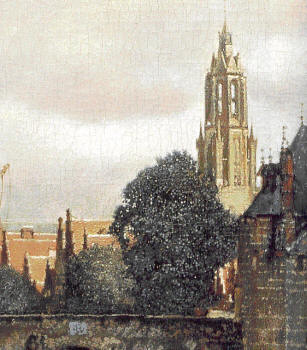
In the View of Delft, the tower of the venerable Old Church is hardly noticeable, whereas that of the New Church has been majestically rendered, although perhaps a bit too wide. One of the most curious details of the picture, pointed out by art historian Kees Kaldenbach, is that the New Church's bell tower is empty. Kaldenbach's research has demonstrated that the old set of carillon bells of the New Church's tower had been hoisted down in the spring of 1660 during a restoration headed by the renowned Hemony bellmakers. Accordingly, the empty tower points to the year 1660 confirming the painting's date generally proposed on stylistic grounds. Furthermore, Kaldenbach posits that given the full green foliage and the active maintenance works on the ships moored at the shipyard (getting ready for the opening of the legal fishing season on June 1st), it follows that the scene was intended to depict an early morning in the first half of May.
Scientific analysis suggests that the painting was on Vermeer's easel for quite some time and was likely finished in 1661 to 1663.
The New Church, which contains the tomb of William of Orange, The Father of the Fatherland, is the most important building in Delft. According to Delft's first historian, Dirk van Bleiswijk, the New Church had its origins in 1351. It was built around a wooden church which remained until 1420. Exactly 100 years later, in 1496, the tower was finally ready. The tower was struck on 3rd May 1536 by a heavy lightning which, fanned by a strong wind, led to the subsequent fire that devastated a great part of Delft. Critics have variously hypothesized that Vermeer painted the sunlit tower too wide, too far to the right or left or too small, although none can be substantiated by measurements.
Thoré-Bürger and the View of Delft

Art French critic Théophile (who used the pseudonym Thoré-Bürger) is generally credited with having rediscovered the art of Vermeer in the middle of the 18th century. He began his study of Vermeer with an account of his first encounter with the View of Delft in The Hague, describing it thus:
"A superb and most unusual landscape [that] captures the attention of every visitor and powerfully impresses artists and connoisseurs. It is the view of a town, with a quay, old gatehouses, buildings in a great variety of styles of architecture, garden walls, trees and, in the foreground, a canal and a strip of land with several figures. The brilliance of the light, the intensity of the color, the solidity of the paint in certain parts [produce] an effect that is both very real and nevertheless original."
To Thoré, Vermeer's work embodied the purest expression of what he considered the ultimate purpose of art: to record and honor the activities of daily life for everyday people, thus coloring the aura of the Delft master with his own leftist agenda. Thoré extolled Dutch art for its direct appeal to simple human virtues, making it an art for the people (l'art pour l'homme). He was, however, not only a man of politics but of great aesthetic sensitivity who admired Vermeer's use of sparkling impasto and pearly luminosity.
Thoré devoted 20 years to travel and research for his study of Vermeer, and as early as 1860, he began purchasing Vermeer paintings. A Lady Standing at a Virginal was acquired sometime before 1876, the Woman with a Pearl Necklace was bought from Henry Grevedon in June 1866. A Lady Seated at a Virginal was purchased for a mere 2,000 francs in 1867. The impact of Thoré's research and interest was enormous. Vermeer rapidly gained a reputation as one of the greatest Dutch artists of the 17th century, triggering a buying frenzy among wealthy American businessmen and art collectors who vied to snap up the few Vermeer paintings still on the art market.
Although Thoré's criticism today may appear politically motivated, his early recognition of the important masters of French 19th-century painting and the Dutch Baroque place him at a seminal point in art history. His most important contribution was in the history of taste and collecting, particularly the reevaluation of Dutch artists as well as being an early supporter of Impressionism.
The Kolk
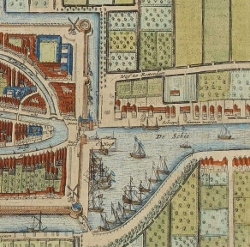
Vermeer's View of Delft depicts the city of Delft as viewed from the south, overlooking a triangular body of water known as the Kolk. This area took shape initially as a bastion constructed in 1573 during the modernization of the city's fortifications. In 1614, it was excavated again, giving rise to the present triangular harbor. Both gates and the town wall were demolished in the 1830s, and most of the stepped-gable buildings in the painting have been replaced by modern facades. Only the New and Old Church remain.
The Kolk served as the primary departure point for travel to other cities and countries through the Schie and Maas waterways. It provided access to Rotterdam, Schiedam, Delfshaven, as well as to Flanders, France, England and destinations across the world. Beyond the harbor, the deep brown city walls stretch, interrupted only by the small Kethel Gate and the larger Schiedam Gate with its clock tower. The Rotterdam Gate, recognizable by its twin towers, no longer stands. None of these architectural features have survived. After, Vermeer over-repainted the surface of the water slightly moved by gentle breeze. The reflections of the Rotterdam and Schiedam Gates were stretched downward anchoring the skyline to the forward quay.
Vermeer's choice of portrayal presents an atypical profile of Delft. Conventional cityscapes of Delft usually highlighted the town's most distinctive landmarks. The Old Church, a truly venerable monument, can scarcely be identified in the distant left center of the composition.
How Vermeer's view looks today

The photograph on the left was captured from a location very close to where Vermeer painted the View of Delft, approximately at the same height from the ground. Historians unanimously agree that the artist worked from the second story of an inn that has long since been demolished.
Considering that this area of Delft was highly bustling, the apparent tranquility depicted in Vermeer's artwork likely results from the artist's manipulation, rather than being a factual representation. However, with the right timing, a touch of luck, and a few clouds, it's conceivable that by standing where Vermeer once stood, one could still capture a fraction of the ambiance of Vermeer's masterpiece. After all, the New Church's spire remains visible, the shoreline retains its proper position, and a slight glimpse of the Old Church's four spires peeks over the ordinary modern skyline.
Yet, even with the expanse of the Dutch sky overhead and the two pivotal landmarks accurately aligned, there's an oddly "off" quality about the scene. Standing precisely where Vermeer created, everything appears more distant, significantly farther away. At this precise intersection, facing the sole fixed point that can be objectively matched and compared with one of Vermeer's paintings, a sense of uncertainty arises. It prompts doubt regarding the extent to which the painter took artistic liberties in interpreting the real world, constructing a reality whose individual components might be contested in terms of factual accuracy but whose artistic harmony is overwhelming.
Traveling by boat in the 17th-century Netherlands

View of Delft from the Northwest (detail)
Hendrick Cornelisz. Vroom
1615–1634
Oil on canvas, 71 x 162 cm.
Gemeente Musea, Delft
The level expanses of the 17th-century Netherlands were crossed by canals that had been dug to regulate the flow of water, but at the same time doubled as an extraordinarily effective means of transportation, more practical than any way on land. Although the centers of Dutch cities had paved roads, in the back streets and outside the city it was sand, dust and mud. Riding by carriage meant a bumpy and often muddy road. Alternatively, Dutch towns were connected by a network of line services by tow barges (trekschuit), then one of the most advanced public transport systems in the world. They provided scheduled day-time transportation which was frequent, dependable and affordable.
Traveling by barge was a little slower but far more comfortable than by carriage. One could enjoy the view of the landscape, have a conversation with the skipper or read a book while the boat slowly glided through the water pulled by one or two horses. This unique mode of traveling influenced communication within Dutch society as well. Boat travel encouraged men and women from different geographical locations to meet and exchange information and opinions in leisurely freedom. People of diverse social spheres, religions and political persuasions mingled and sooner or later familiarized.
Vermeer no doubt knew the waterways and used them. The service between Delft and The Hague (the administrative capital of the United Provinces and important art center) ran every two hours in both directions taking from one to one and one-half an hour to arrive. The Delft-Leiden service is said to have carried 170,000 passengers annually during the 1660s.
In the foreground of the View of Delft, one can see a tow barge put into service in 1655 when the line service to Rotterdam was started. Vermeer thus shows us a recent transport innovation in the Delft region.
Marcel Proust and the View of Delft
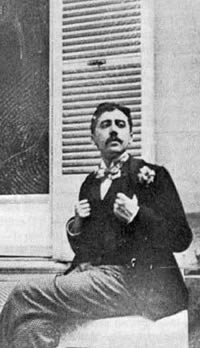
Marcel Proust
Behind and to the left of the Rotterdam Gate is most likely the passage eternalized in writing by Marcel Proust in À la recherche du temps perdu.
Proust describes an elderly writer Bergotte who visits a Dutch art exhibit and, while examining a detail of Vermeer's View of Delft, falls ill and dies. That scene, that painting, described as a "Little patch of yellow wall, with a sloping roof" has attracted the attention of a multitude of critics. Bergotte's final thoughts before dying, perhaps more than any other, faithfully reflect Proust's idea of art.
Although not all experts agree on the precise location of Bergotte's "'little patch," Proust writer Jeffrey Mayers believes that "the famous little patch of roof (not wall) that the writer Bergotte sees in a moment of epiphany before his death appears just next to the pointed left turret of the Rotterdam gate, amid the warm browns and blues of the stone buildings and tiled roofs, and it provides a golden contrast to the rich red roofs on the right side of the painting."

Why did Vermeer paint the View of Delft?
The View of Delft was Vermeer's largest and most time-consuming work of his entire oeuvre, except perhaps for the elaborate Art of Painting. Since nothing has come down to us concerning the artist's intentions in regards to this or any other work, art historians have attempted to fill the gap. Walter Liedtke, for example, believes that the view could have been commissioned by Vermeer's patron, Pieter van Ruijven. who had collected more than half of the artist's artistic production. Furthermore, Liedtke points out that Van Ruijven's collection contained three other small-scale cityscapes of Delft by Vermeer as well as three architectural paintings by Emanuel de Witte, including a patriotic view of William the Silent's tomb in the New Church which Vermeer spectacularly highlighted in his view. Van Ruijven would have also been aware of the historically proclaimed relation between an artist's reputation and the fame bestowed on his city.
Dutch citizens strongly identified not only with their republic but with their city of birth. Their civic pride is testified by innumerable Dutch cityscapes, many of which are so similar to one another that they are virtually indistinguishable except for a few characteristic church towers or large civic buildings.
Dutch pride
The Dutch were enormously proud of their country, their way of life and the cities in which they lived. They wrote richly illustrated city histories that celebrated the achievements of their most renowned citizens and the beauty of their monuments. Large-scale engraved maps were printed which portrayed the city streets, the canals and gardens in extraordinary detail. No people in history portrayed their landscape as frequently and with such attention to detail as the Dutch.
The Dutch were the first to formulate the cityscape as an independent genre of painting. Some art historians believe that the topographical urban motif evolved out of highly developed Dutch cartographic traditions rather than from traditional background scenery in pictures devoted to religious, historical or mythological subjects. Civic officials commissioned the new scenes to record their towns' historic towers and spires, as well as the stately new buildings and imposing fortifications that reflected wealth and authority. Residents bought portraits of their cities on the open market and proudly displayed them in their homes.
Although we do not know why Vermeer, the interior painter, created such an atypical and time-consuming work as the View of Delft, it is possible that his patron and Delft burger Pieter van Ruijven commissioned it.
While the artist did break the Dutch landscape mold of prominently displaying the town's most important monuments, he did follow the conventional cityscape formulae whereby poverty, litter and slums were completely erased. Nonetheless, Vermeer was too original of a painter to blindly adhere to any established formula.
In the present work, he narrowed his focus to portray the bastions of his native town from a selective viewpoint, on one particular moment while a few sparse cumulus clouds lazily pass overhead casting their shadow over a good part of the composition. Art historians have narrowed that time to about 7:30 (see the clock on the Schiedam Gate) on a morning of the month June 1661. A moment later, the cloud would have moved on and the scene we now see would no longer be as Vermeer represented it.
Rather than representing a viewpoint that afforded the best panorama of the town and its monuments, Vermeer selected one which would convey a deeper and, perhaps, more personal sense of identity with his beloved city.
Listen to New Church carillon music
![]() Preludio V in C [1.78 MB]
Preludio V in C [1.78 MB]
Matthias van den Gheyn
performed by:
Marianna Marras, New Church Delft, 1995.
:
CARILLON DELFT
Bespeeld door drie Delftse beiaardiers http://www.carillon.org/cd/pages/delft_1.htm
Did Vermeer use a camera obscura in the View of Delft?
One of the most beguiling aspects of Vermeer's working method was the artist's hypothetical use of the camera obscura, a sort of primitive photographic camera. After an initial positive response of the art community regarding its use, some art historians have moderated their enthusiasm or completely backed away. While they still admit Vermeer was familiar with the workings of the camera obscura, they believe that many of the stylistic characteristics attributed to the camera were conceived independently from the device.
Of course, no documentary evidence indicates whether or not Vermeer actually set up a camera obscura on the second floor of a long-lost tavern where the viewpoint of the View of Delft was located. Much less do we know if he employed it for temporary observation or during the arc of the painting process. Nevertheless, the hypothesis that Vermeer used a camera obscura at some stage in the working process of the View of Delft gained validity because of the distinctive effects of light, color, atmosphere and the curious presence of signature optical effects produced by the mechanism.
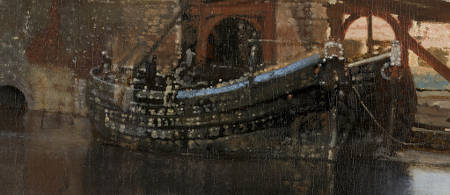
One of the most vexing questions regarding Vermeer's working methods is the artist's presumed use of the camera obscura, a sort of primitive photographic camera. After an initial positive response, some art historians have moderated their enthusiasm or completely backed away. While they still admit Vermeer was familiar with the workings of the device, they believe that some of the stylistic characteristics of his paintings that are attributed to camera obscura vision were conceived independently from the device.
Of course, no documentary evidence indicates whether or not Vermeer actually set up a camera obscura on the second floor of a long-lost tavern where the viewpoint of the View of Delft was located. Much less do we know if he employed the device for temporary observation or during the arc of the painting process.
The most convincing trace of the camera obscura image is constituted by the artist's translation of an optical phenomenon, called disks of confusion, into painted dots termed pointillés which in the View of Delft are particularly abundant (disks of confusion are produced by imperfect 17th-century lenses that spread out sharp highlights in nature into tiny, sequin-like circles). Pointillés teem along the lower side of the right-hand barge creating a sensation of shimmering reflections of light bouncing off the water's surface. However, it should be remembered that the camera obscura produces a poor image in low lighting conditions. Furthermore, the device requires great light to create disks of confusion, and only on shiny objects. Certainly, the light represented in the View of Delft would have been too low to produce them on the camera's screen in correspondence to the shadowed passages of the foreground. Vermeer experts believe he probably availed himself of artistic license regarding the disks of confusion with which he had become familiar through long hours of camera observation.
Vermeer was not the only painter who knew the camera obscura. Camera obscuras were sometimes acclaimed in the 17th century for the naturalistic images that they created. They present an instantaneous living image, where movements of clouds, water and birds are visible. Color and contrasts of light and dark are distilled, giving an added force to the image which must have intrigued any painter of the time. In the View of Delft, all of these phenomena are present.
In today's world inundated with images, it is difficult to appreciate the impact that the camera's image could have provoked in a world where all images, except for natural reflections, were deliberately and tediously crafted by hand. Contemporary literature relates some of the magic that accompanied camera obscura viewing that we can no longer imagine.
Delft draws inward

The Old Church on the Oude Delft in Delft
Jan van der Heyden
1675
Oil on panel, 45 x 57 cm.
National Gallery, Norway
By the time Vermeer reached his artistic maturity, many of Delft's best painters had fled to the rapidly growing Amsterdam. However, only a few years before Delft had inexplicably attracted some of the rarest talents of the United Provinces. The short stays of Pieter de Hooch, Paulus Potter, Carel Fabritius and Jan Steen around 1650, coupled with the permanence of Vermeer, gave rise to the so-called School of Delft.
Before the arrival of these painters, Delft had been only a minor center of artistic activity. What brought such artists may have been the city's long and venerable history, its lovely streets and quiet, aristocratic atmosphere which pulled visitors in from all over Europe. In this quintessential Dutch environment, these painters evidently found the tranquility to forge a naturalistic yet measured art that some art historians have described as classical.
Curiously, the years of Delft's maximum artistic ferment did not correspond to its economic and political climax which had been reached years before. As art historian Peter C. Sutton wrote: "Over the course of the 17th century, Delft drew inward. While occasionally still serving as a theater for political events, the city gradually surrendered its active role in the nation's affairs. A small group of families espousing aristocratic ideals and orthodox Calvinism came to dominate the civic administration. Wealth remained but was used more and more conservatively. The entrepreneurs were increasingly replaced by more cautious rentiers; while capital could readily be found for high-yield ventures such as those of the Dutch East and West Indies Companies, little money was reinvested in local business. At a time when trade and industry were expanding briskly throughout Holland—and nowhere so dramatically as in Amsterdam—Delft's economic base was vanishing. Its crafts and porcelain manufacture and tapestry weaving remained strong, but many businesses languished. The textile industries, suffering from competition with the English, curtailed their activities or moved elsewhere and by 1667 the city's breweries had fallen in number from more than 100 to 15. Land reclamation and the damming of rivers had transformed Delft from an open port to a virtually landlocked city. Commercial shipping at Delfshaven was increasingly rerouted through the burgeoning port of Rotterdam."

